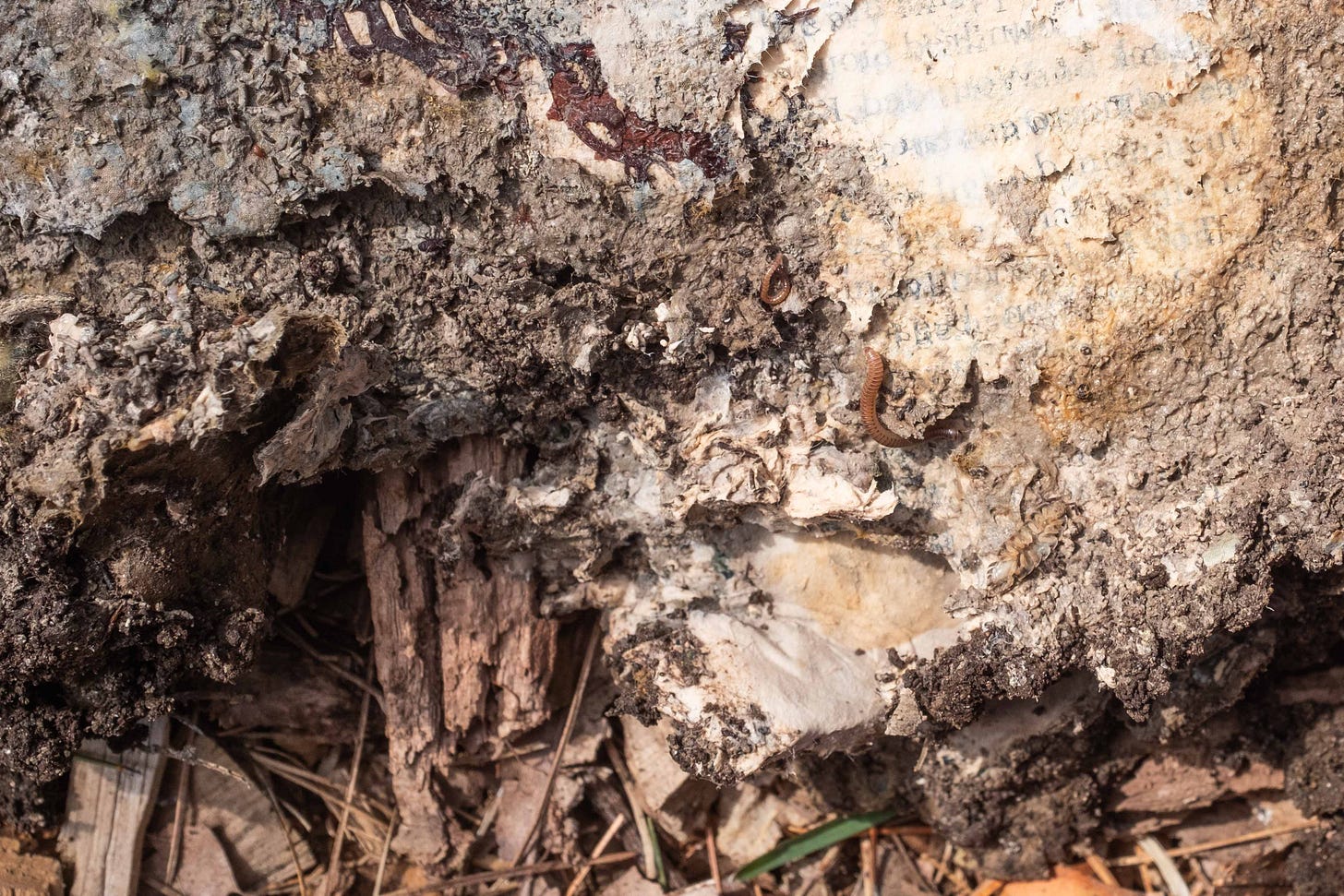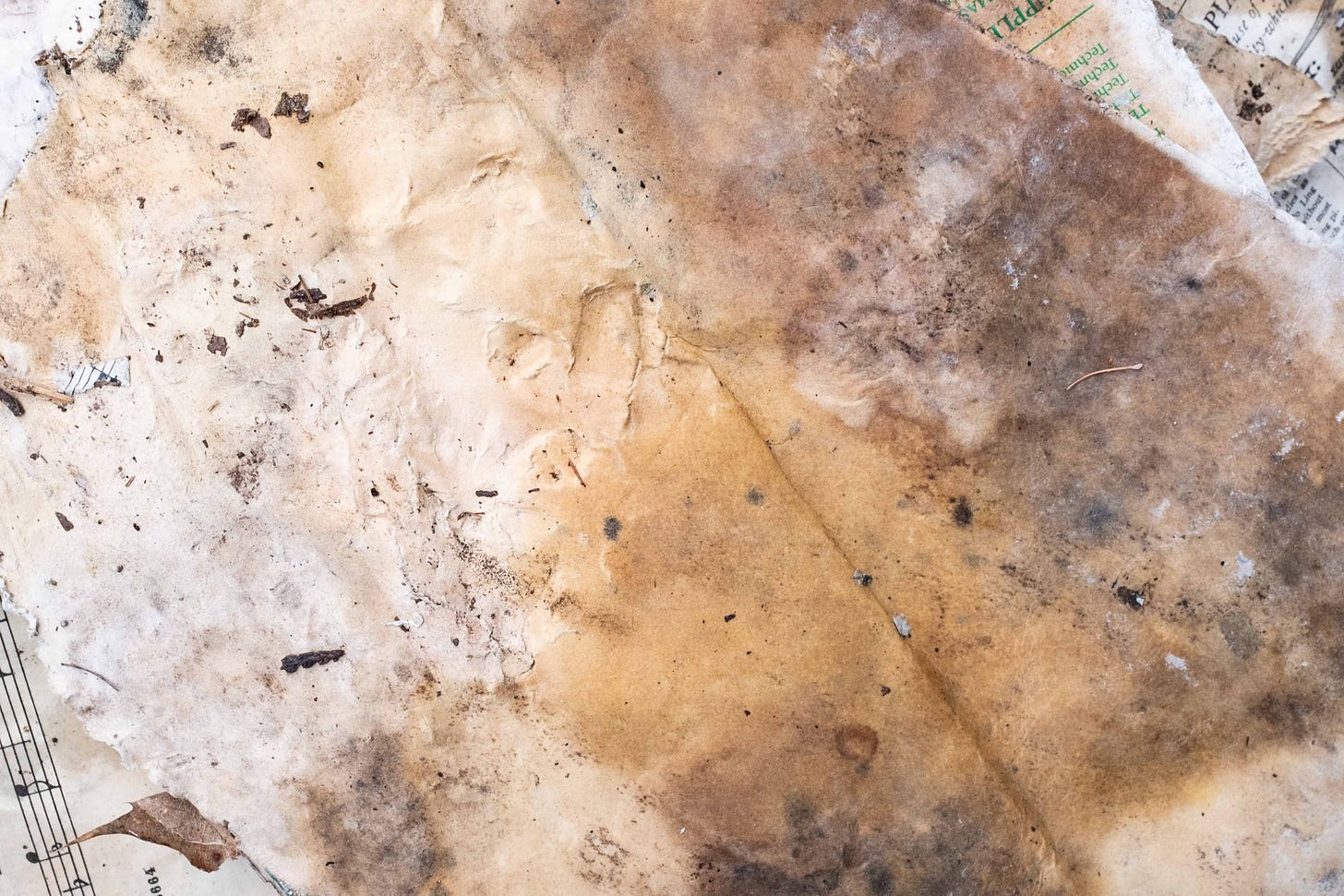Sometimes it’s impossible to keep ideas at bay.
Like, who wouldn’t want to document old hairbrushes, colorful digital micro-cameras and netting that once held sweet potatoes?
Unless, of course, said objects are just one of hundreds stored for years in boxes in your studio…all filled with expectations of some kind.
But what if, instead of documenting these, other objects in other places - - like, say, a ‘garden library’ in the yard, were calling?
The blue cover of this book goes well with that mandarin label and that big blue box, but really, if you had to choose, which would motivate you more?
And that’s the point. A gal has to choose.
There is only so much time in a day, week or year, not just to make the images themselves, but also to organize them in a photo library (which, as you know, I’m trying to make smaller)1, to manage creating a portfolio, and then to actually do something with them, like submitting them to shows or whatever.
This whole mindful editing process is starting to make sense - - Who knew it actually begins before ever creating an image?2
You might have known and understood this photographic reality, but for me, at this moment, it’s a revelation…
…Because there was that personal photo essay I had always thought I’d do on my stuff…a natural extension from years documenting the landfill and thinking about that powerful short film The Story of Stuff.
…and because, even as enticing as those boxes may be, filled with messages about consumption, personal overwhelm, and wasted plastic, there is also this wheelbarrow full of book covers.
What might these plastic/paper objects have to say about consumption?
And might it be more interesting, at this point, to focus on mold and not plastic?
I mean, really, mold has been around for millennia and will be around long after humans are gone.3
Check out these abstractions they made. They beckon, drawing me into an unspoken conversation about, well, stuff…Nothing particular, at this point, just intangible musings that flow back and forth between my brain and some deeper instinctual place.
These impressions, created in one of my ‘garden library’ books, scream: “Pay attention…There’s wonder among us.”
I’m listening. I’m looking. I’m here.
And then the light falls on those boxes in the studio and I’m distracted, again, by all the colorful and shiny things they contain. If that isn’t a demonstration of plastic’s power to seduce, I don’t know what is.
As I write this, that anxious pit arises. If I choose to not do the photo essay I’d planned using the stuff in these buckets, what’s next? What do I actually do with all that stuff?
It would be so easy to dump them all into big plastic bags and throw them away, but I won’t, at least not yet. There are useful items in there…for someone, somewhere.
I can say, "no” to the project and “thank you” to the objects for hanging out with me, but where should they go now?4
These yellow dots are as compelling as those yellow plastic objects above, and yet, there is more to them than color. These are alive, the basis for something. Maybe even a cure for some disease. Or, as my husband reminded me, the cause of some sickness.
The bottom line: the yellow dots of mold are engaged, connected and part of something larger than themselves.
Yesterday I turned over a music score and found these wood chips, embedded in the fibers of the paper. They are, in fact, kin - - why wouldn’t one attach itself to the other?
And then I removed this book from between its rotting brethren,
and remembered seeing that face before, last fall, when I first removed it from the library, back when you could still see all four corners of the page.
And I wondered, why, exactly, have I been so full of angst these past weeks, distracted by those buckets of stuff, when there were these treasures to explore?
Yes. These are indeed treasures. They once sat on our shelves and we may have occasionally referred to them. But now there is the internet and much of their content feels irrelevant…not in and of themselves, but because they don’t include the other narratives of all those people who for millennia have been marginalized and ignored.
I explore the progress little creatures have made, integrating the Dictionary of History into the soil and am in awe. Afraid to disturb their work any further, I put it back on its ‘shelf.’
In the introduction to the 2020 edition of Braiding Sweetgrass, Robin Wall Kimmerer refers to a ‘call and response’ process many are currently engaged in. The call arises “from a shared sense of longing and the response building in a chorus of the Great Remembering.”5
This remembering is what I think I am experiencing with the transformation of these books. They are calling me away from “the noise of the world…the commodification of nature…[and] the erasure of knowing oneself to be good medicine for the land.”
Why spend energy with objects that are not, in fact, “good medicine” for anyone?
Why give that plastic stuff more power than it deserves, making it center stage, again?
“No, thank you.”
Once again, my camera has guided me to unexpected places.
What intoxicates is the idea of spending more time with these objects, these images and the ideas they contain. There’s no turning back, not that I’ve ever left. Compost. The Landfill. Mold in books. They’re of a piece - - stories of the earth embracing, absorbing and transforming that which we give it, over and over again.
Those shiny objects in those boxes just don’t fit this narrative.
What narrative thread centers you?
I’d love to hear your responses in the comments section. Remember, if you hit reply to this e-mail, I’ll never see your glorious words.
Here’s to another exciting week at 13 Tons of Love. As always, thank you for sharing your time and this space with me.
If you find the images or ideas here compelling, please share with others!
With gratitude for you being you,
Lyn
See my most recent posts, Ritual & Editing and Old Friends (which considers minfulness and editing).
More more on mindfulness, check out last week’s post Old Friends.
Mold - - Please know that I am not a micro-biologist and make no claim of any expertise when it comes to mold, which is a fungal growth that forms and spreads on various kinds of damp or decaying organic matter. There are many different mold species that come in many different colors. Molds are sometimes referred to as mildew (USDA).
The dust-like, colored appearance of molds is due to the formation of spores containing fungal secondary metabolites. The spores are the dispersal units of the fungi. Not all fungi form molds (from Wikipedia).
You’ll have to stay tuned for a future post where I may or may not tell the story of all that stuff. Will it remain a mystery…or an enticing narrative? We’ll just have to see.
Braiding Sweetgrass is well known, as is Robin Wall Kimmerer. Nonetheless, like Shakespeare, you can keep rereading and always learn something new about our relationship to the earth and to ourselves.




















